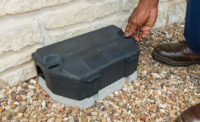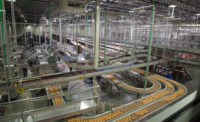The right air handling equipment—including supporting equipment—is vital to maintaining effective snack and baking production environments. Not only is this equipment responsible for distributing heated and cooled air throughout the buildings, but it can significantly impact the quality of the workplace environment, among other safety and quality considerations.
Sanitation matters
Air handling equipment must be frequently cleaned in order for it to work properly. Goodway Technologies, Stamford, CT, offers the CC-201T Coil Cleaning System to make it easier to perform on-the-go cleaning of coils in mini-split systems, packaged terminal air conditioners and interior air handlers, says Tim Kane, president. “It includes a portable design and custom pump system that uses a pressurized water system to safely remove dust, dirt and debris from a variety of coils. It can be connected to a water source for continuous cleaning, or there is a convenient built-in storage tank that holds eight gallons of water.”
The coil cleaning system works with Goodway’s tablet system, Kane explains. “CoilShine-T and CoilShine-T-BIO consist of a simple, two-step process using one tablet to clean and another bio-blasting tablet to help protect against odor and deliver better indoor air quality. The lightweight, premeasured tablets make for safer and easier transporting—removing the risk of a chemical spill and eliminating the burden on technicians to haul around gallons of cleaner.”
It’s compatible with the company’s CoilShine drop-in tablet technology, which eliminates the need to carry around gallons of heavy liquid cleaner, Kane says. “The vision behind the CC-201T is to allow technicians to more efficiently move from one job to the next, while still achieving an effective and powerful coil cleaning.”
Proper coil cleaning can help to reduce costs and improve system efficiency, notes Kane. “Dirty HVAC and refrigeration evaporator coils and condenser coils can reduce system efficiency by up to 70 percent, dramatically increasing costs and reducing the operating life of expensive equipment.”
Features of the CC-201T include a complete, industrial coil cleaning system; powerful, yet safe, 200 PSI, 0.9 GPM coil cleaning pressure with an 8-gallon tank or continuous water supply; unique COILSHINE tablet system (cleaner and bio protectant); and a design that accommodates all accessories.
Camfil USA, Inc., Des Peres, MO, offers the CamCleaner, a standalone air purifier that is an unducted, modular piece of equipment typically suspended horizontally from the ceiling, says Mark Davidson, food and beverage segment manager. “In many industrial segments, including food processing facilities like bakeries, for example, there are production processes that generate a high level of particulate or molecular contaminant. When flour or breading residue is drawn into existing air handling units, it can overwhelm air filters and restrict the airflow.”
When that occurs, there isn’t enough force to remove the dirt from the air, and it hangs there like smog, or accumulates on the equipment and floors. “Not only is this a food safety issue and additional labor expense, but it’s an employee health issue, as well,” says Davidson. “I was in a plant recently where residue had accumulated on the floor and stairs, making it slippery to walk on.”
CamCleaners can be easily positioned above those challenging areas on the plant floor, drawing air through a series of filters selected for the particular application. “The filters can range from pleated prefilters to pull-out heavy contaminant loads, molecular filters to control odors/irritants or even HEPA filters to protect highly sensitive areas where cross-contamination can ruin an entire batch,” Davidson explains. “The clean air can then be returned back into the plant near its source, or it can be directed elsewhere in the plant to help improve positive pressure.” The CamCleaner also comes in a vertical floor model.
Ventilation and safety
“Thanks to FSMA and increased food safety awareness in general, industrial ventilation—both process conditioning and process environmental supporting roles—are under scrutiny in the snack food and wholesale bakery industries,” says Michael Anderson, sales manager, Air Management Technologies, Inc., Lewisburg, PA.
There is no one-size-fits-all solution. The conversation must be focused on each individual application: the product, the existing environment, the purpose, and even the existing building, notes Anderson. These factors will dictate the right type of equipment for the job to help ensure safety while remaining cost-effective.
According to Anderson, multiple considerations should enter the discussion.
Hygienic design. Is this in a direct process area? Are there USDA requirements? Will there be full interior washdown?
UV lighting. This is effective for applications where there may be water carryover or condensation.
Increased air filtration. MERV ratings and synthetic media impact maintenance and operational costs. As filtration levels increase, so does motor horsepower to overcome the filter resistance. High synthetic MERV level filtration can become very expensive if replaced frequently. In many areas dual filter racks to remove larger particulates in a more affordable synthetic media (MERV-8 filters followed by MERV-13) make more sense.
Evaporator coil construction. Options include conventional with aluminum fins, various fin coatings, copper fins and full stainless steel. Each offers different costs, performance, heat transfer and anticipated service life based on application. For instance, proofers, retarder and spiral coolers have significantly different coil construction requirements than makeup and packaging areas.
Space pressurization. A full understanding of pressurization requirements of each zone in a facility is necessary—compared not only to adjacent spaces, but also outside. Every potential opening in the building for pressurization relief must be considered, from existing dampers to dock door gaps around the seals. Incorrect design can contribute to high-humidity environments that promote mold growth. Other overlooked design criteria may cause air to transfer through: proofers, creating an inconsistent production environment; spiral coolers, increasing humidity and contamination potential during product cooling; and blast freezers, which can cause condensation and greatly increase ice loading on the evaporator coils, resulting in significantly higher defrost requirements.
Thermal bridging. Not only must buildings be constructed to prevent thermal bridging (metal or conductive materials joining a colder environment to a warmer, humid environment) but also air handling equipment, ductwork, utilities such a piping, and even conduits. Humidity will always try to equalize between areas. Typically, areas of low moisture are cooler than adjacent rooms. Vapor pressure is extraordinarily powerful, and if moisture can transfer between two spaces, it will, creating condensation and a food safety hazard.
Humidification. Boiler steam directly sprayed onto product is a concern in some applications, as steam boilers are typically treated with chemicals to prevent scale buildup. Standalone “clean steam” generators, which can be natural gas or electric, are used in some oven and/or proofer environments where potential chemical contamination can become a concern. From a food safety and operational perspective, adiabatic (high pressure water droplet) humidification is preferable in proofer and fermentation environments as it quickly evaporates, is free from chemicals, does not require the large amount of energy to generate steam from incoming facility water, and as it evaporates offers a cooling benefit which can be very beneficial in helping control proofer dry heat temperature.
“As always,” concludes Anderson, “you can bring all the knowledge, design and equipment construction together. But without the proper controls package, correctly programmed sequence of operations, and capabilities to have the system intelligently adjusted based on daily, seasonal and operational environments, the industrial ventilation system will not have the ability to provide a consistent environment for maintaining product quality and food safety.”






